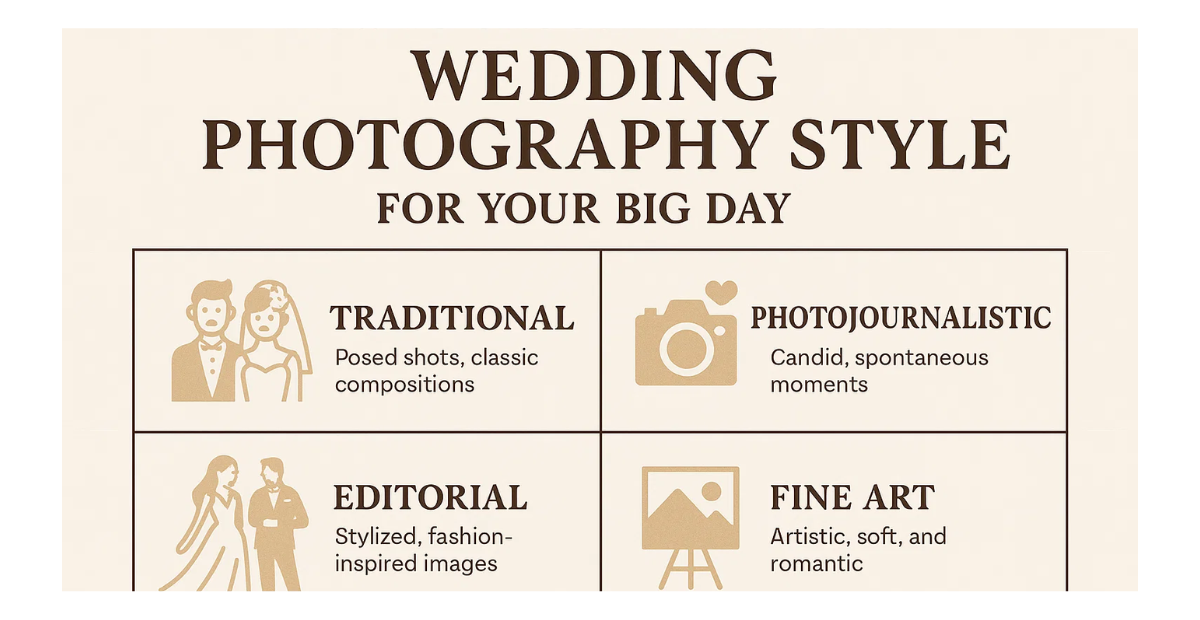How to Choose the Right Wedding Photography Style for Your Big Day


Your wedding day is one of the most significant moments of your life—a day filled with emotions, laughter, rituals, and unforgettable memories. Capturing those moments in the right way is just as important as the day itself. Choosing a wedding photography style that reflects your personality, wedding theme, and expectations can be the difference between ordinary pictures and timeless visual memories.
With the evolution of wedding trends and an explosion of creative expression, there is no single way to document a wedding anymore. From classic elegance to raw candid moments, every style of photography offers a unique perspective. This guide will help you understand the popular wedding photography styles and how to choose the one that fits your special day perfectly.
- Understand Your Preferences as a Couple
Before exploring different photography styles, take time to reflect on what kind of couple you are and what emotions you want your photos to evoke. Are you drawn to storytelling, fine art, or documentary-style imagery? Do you prefer posed shots or natural, spontaneous moments? Browse through wedding albums, Pinterest boards, or social media to see what catches your eye. Identifying your aesthetic preference will give you a clearer direction when choosing your photography style.
- Explore Popular Wedding Photography Styles
Here’s a look at some of the most popular styles in today’s wedding photography landscape:
a. Traditional Photography
This classic approach involves posed photos with emphasis on key moments such as the exchange of vows, group shots, and ceremonial rituals. It is structured, well-lit, and ensures that no important aspect of the wedding is missed. Ideal for couples who want a more formal and complete documentation of their day.
b. Candid Photography
Also known as photojournalistic or documentary style, this focuses on capturing unscripted moments as they naturally unfold. From stolen glances to laughter during the mehendi, this style captures emotions in their rawest form. It requires a photographer with a good eye for timing and emotion.
c. Fine Art Photography
This style blends creativity with aesthetics. Fine art photographers use lighting, composition, and backdrops to create magazine-worthy, stylized images. If you’re looking for dreamy, editorial-quality portraits, this is a great choice. It’s often more posed but focuses heavily on artistic flair.
d. Editorial Style
Inspired by fashion photography, this style focuses on creating high-end, styled shots. Think dramatic lighting, stylish poses, and impeccable detail. It’s perfect for couples who want their wedding album to look like a luxury magazine spread.
e. Lifestyle Photography
This is a blend of candid and posed shots. Lifestyle photography captures real-life events in an artistic way, often with minimal direction. It feels natural but polished and is perfect for couples who want authenticity with a touch of direction.
- Consider Your Wedding Venue and Theme
The location and theme of your wedding can significantly influence your choice of photography style. For example:
- An outdoor beach wedding may lend itself beautifully to candid or lifestyle photography.
- A traditional temple wedding might be better suited to a mix of traditional and documentary styles.
- A luxurious indoor venue might pair well with fine art or editorial-style photography.
The venue’s lighting, layout, and ambience will also impact the type of photography that works best, so it’s a good idea to discuss this with your photographer during the planning phase.
- Set a Realistic Budget
Each photography style may come with different pricing, depending on the photographer’s expertise, equipment, and the complexity of editing involved. Fine art and editorial styles, for instance, often require more planning, lighting setups, and post-production, which can increase costs.
Know your budget and look for professionals who specialize in your preferred style within that range. Remember, photography is an investment. It’s one of the few things from your wedding day that lasts a lifetime.
- Meet with Potential Photographers
Once you’ve shortlisted a few photographers, schedule in-person or virtual meetings. Review their portfolios to ensure their work aligns with your vision. Ask questions about their approach, experience, turnaround times, and how they handle different wedding scenarios.
The right photographer will not only have technical expertise but also make you feel comfortable. Your chemistry with the photographer matters—a lot. You’ll be spending a significant part of your day with them, so ensure you’re at ease in their presence.
- Do a Trial or Pre-Wedding Shoot
A pre-wedding or engagement shoot is a great way to test the waters with your chosen photography style and photographer. It gives both parties a chance to get familiar with each other and understand expectations. It also helps the photographer learn your best angles and comfort levels, which can lead to better results on the big day.
- Be Open to a Hybrid Style
Sometimes, the best wedding albums are created using a combination of styles. For example, a photographer may use traditional photography for ceremonial events, candid photography for behind-the-scenes moments, and fine art for couple portraits. A flexible approach allows you to capture every aspect of your wedding in its best light.
In the context of wedding photography in Chennai, many professionals offer such hybrid styles to cater to the region’s rich cultural diversity and evolving tastes. Whether your celebration is traditional, modern, or a blend of both, choosing the right style (or combination) ensures your wedding story is told authentically.
Final Thoughts
Your wedding photography style should be a reflection of who you are as a couple and how you want your love story to be remembered. With so many incredible styles to choose from, take your time exploring, researching, and discussing with photographers before making a decision. When done right, your wedding photographs will not just document an event—they will become a treasured legacy for years to come.



